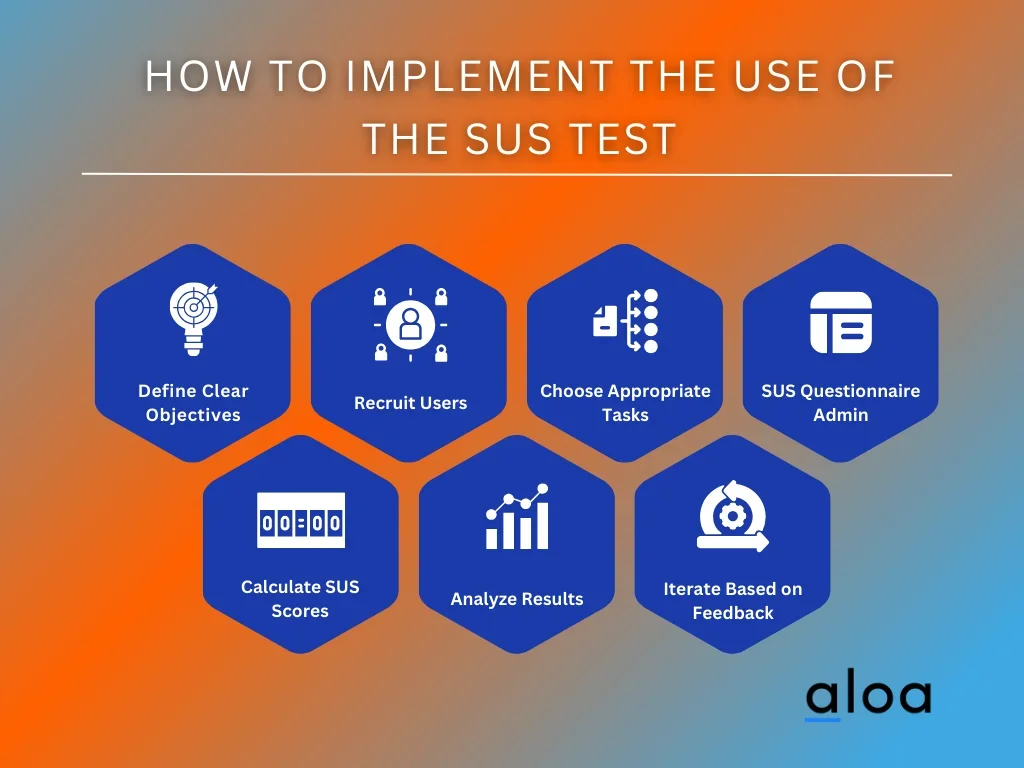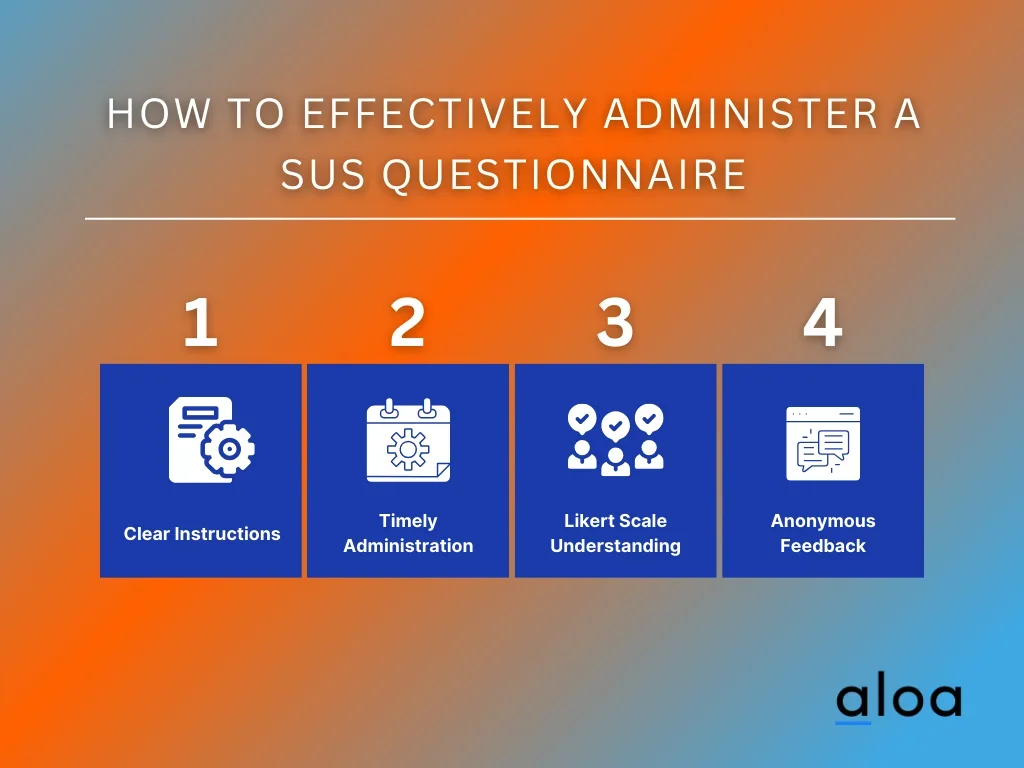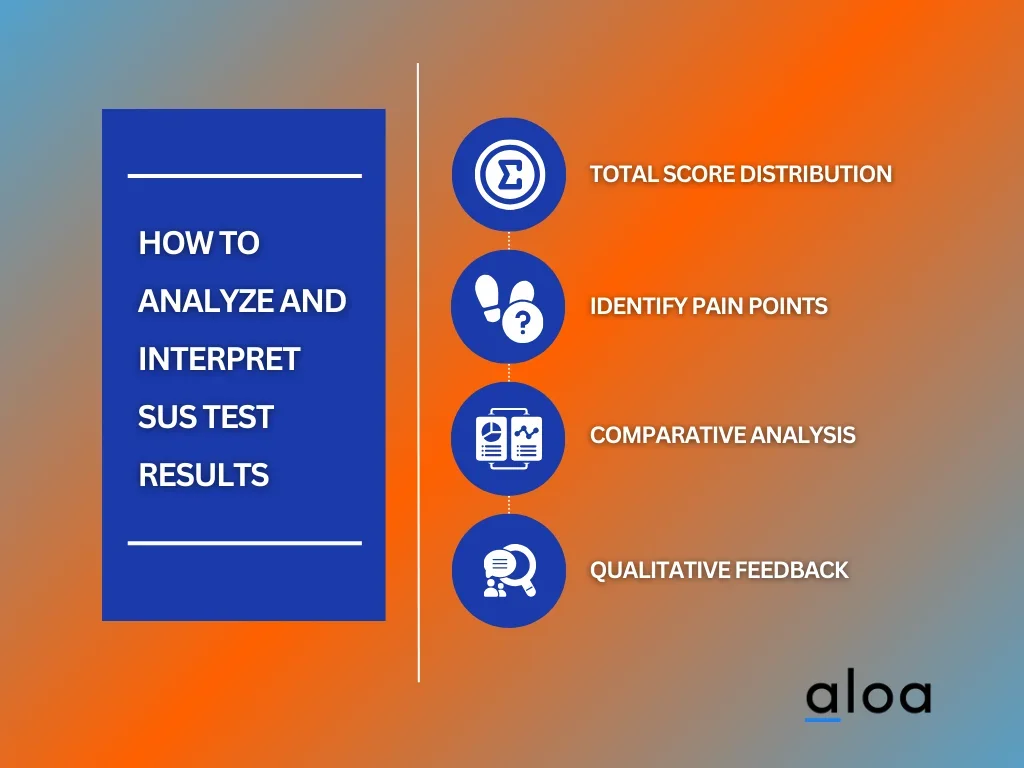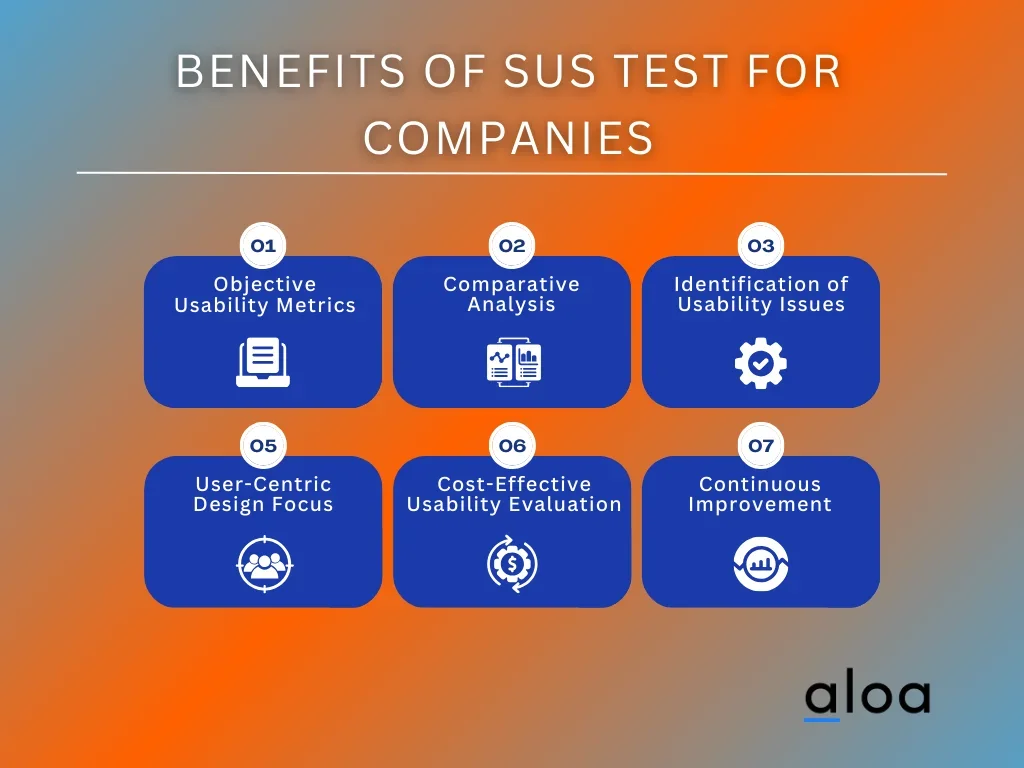SUS test is a robust tool reshaping how companies evaluate and enhance the usability of websites or any digital interfaces. The System Usability Scale (SUS) test provides companies with invaluable insights to drive informed decisions and continual improvement in the ever-evolving digital landscape.
Aloa, a distinguished software outsourcing firm, excels in delivering cutting-edge solutions tailored to meet the diverse needs of its clients. With a focus on innovation and a team of skilled professionals, Aloa ensures seamless collaboration and high-quality software development services that propel businesses toward success.
In this blog, we'll unravel the intricacies of the SUS test, exploring its significance as a powerful tool in evaluating UX product design and user experience across various digital interfaces.
By the end, you'll have a comprehensive understanding of how SUS testing provides valuable insights into usability, enabling businesses to enhance their products and services for optimal user satisfaction.
Let’s dive in!
What is the SUS Test?

The SUS test is a widely used method for assessing the usability of a system, product, or service. The test consists of 10 questions that users answer after interacting with a specific system. These questions capture subjective perceptions of usability, focusing on ease of use, efficiency, and overall satisfaction.
The scoring of the SUS test is based on a Likert scale, ranging from strongly disagree to strongly agree. Responses are converted into numerical values, and the overall score is calculated to provide a quantitative measure of usability. A key feature of SUS is its simplicity and ease of administration, making it suitable for various applications.
The resulting SUS score allows for benchmarking and comparison across different systems, making it a valuable tool for usability practitioners and researchers. In essence, the SUS test offers a user-centered approach to evaluating and improving the design and functionality of digital interfaces.
How To Implement the Use of the SUS Test
Delving into the realm of usability assessment, implementing the System Usability Scale (SUS) test can significantly enhance your understanding of user experience. Here is how to implement this versatile tool effectively in your website or system, ensuring insightful evaluations that pave the way for improved usability and user satisfaction.

Step 1: Define Clear Objectives
To effectively implement the System Usability Scale (SUS) test, defining clear objectives for your usability evaluation is crucial. Clearly articulate what specific insights you aim to gain from the SUS test, whether identifying usability issues, comparing design iterations, or benchmarking against industry standards.
Next, establish the key performance indicators (KPIs) that will guide your SUS test. This could include overall usability, efficiency, or user satisfaction metrics. Clearly defining these objectives will provide focus and serve as a foundation for designing relevant tasks and questions for your participants.
Moreover, communicate these objectives with your team and stakeholders to ensure alignment and understanding of the intended outcomes. A shared understanding of the goals will contribute to a more effective implementation of the SUS test, ultimately leading to actionable insights for improving user experience.
Step 2: Recruit Representative Users
Ensuring representative user recruitment is paramount in effectively implementing the SUS test. By enlisting participants who closely mirror your target audience, you enhance the validity of the evaluation, garnering insights that truly reflect the experiences of real users.
Here are the key points to consider:

- Target Audience Alignment: Clearly define the characteristics of your target audience so that participants accurately represent those who will engage with the product or system.
- Diversity in Participants: Aim for a diverse pool that includes individuals with varied backgrounds, technical expertise, and usage patterns. This diversity broadens perspectives and uncovers a range of potential usability challenges.
- Utilize Appropriate Channels: Choose recruitment channels aligned with your target audience, whether through user research platforms, social media, or existing user databases, to connect with individuals representing your user base.
- Incentives for Participation: Offer appropriate incentives, such as monetary compensation, Canvas Prints for wall art, or gift cards, to motivate participants. Incentives enhance participation and create a more engaged and authentic user testing experience.
Step 3: Choose Appropriate Tasks
Selecting appropriate tasks is a critical step in implementing the SUS test effectively. Begin by identifying tasks that align with the typical user interactions expected in real-world scenarios. These tasks should represent the system's primary functions and goals, ensuring that participants engage with the features most crucial to the overall user experience.
Consider the complexity of the chosen tasks, aiming for a balance that challenges participants without overwhelming them. Tasks should cover a spectrum of functionalities, allowing for a comprehensive assessment of the system's usability.
Furthermore, clearly communicate task instructions to participants, providing sufficient context without guiding them step by step through the process. This ensures a natural user experience and allows for an authentic evaluation of the system's usability. Lastly, create a task sequence that mirrors the user's typical workflow, facilitating a seamless and realistic testing environment.
Step 4: Administer the SUS Questionnaire
With representative users engaged and tasks aligned, the next pivotal step in implementing the System Usability Scale (SUS) test is the administration of the SUS questionnaire. This phase captures participants' immediate impressions and ensures a structured approach to gathering feedback.
Here are the key points to consider:

- Clear Instructions: Provide participants with clear instructions on completing the SUS questionnaire, emphasizing the importance of honest and unbiased responses. Clear communication ensures that users understand the purpose of the evaluation and feel confident in providing feedback.
- Timely Administration: Administer the SUS questionnaire promptly after participants have completed the designated tasks. This helps capture their immediate impressions, preventing memory bias and ensuring that responses are closely tied to their recent interaction with the system.
- Likert Scale Understanding: Ensure participants understand the Likert scale used in the SUS questionnaire. Clarify that higher scores indicate a more positive perception of usability, while lower scores suggest areas for improvement. This understanding is crucial for accurate interpretation of the results.
- Anonymous Feedback: Emphasize the anonymity of participant responses, fostering a sense of confidentiality that encourages honest feedback. Assure participants that their input is valuable for improving the system and that their individual responses will not be traced back to them.
Step 5: Calculate SUS Scores
Once participants have provided their responses to the SUS questionnaire, the next step is to calculate SUS scores. This involves assigning numerical values to participants' Likert scale responses and applying a standardized formula to derive a final score.
To calculate individual scores, convert each participant's responses to numerical values, sum the scores, and then apply a scaling factor. The formula, developed by John Brooke, involves specific weightings for each question. This standardized approach allows consistency in interpreting and comparing SUS scores across different studies.
The resulting SUS scores provide a quantitative measure of the system's overall usability, offering valuable insights into user satisfaction and interaction. These scores serve as a foundation for data analysis and help prioritize areas for improvement in the user experience, contributing to the iterative process of refining digital interfaces.
Step 6: Analyze and Interpret Results
Analyzing and interpreting the results of the SUS test is a crucial phase that transforms raw data into actionable insights. This step is essential for understanding the strengths and weaknesses of the user experience, guiding future improvements, and ensuring optimal usability in digital interfaces.
Here are the key points to consider:

- Total Score Distribution: Examine the distribution of SUS scores among participants to understand the overall perception of usability. A wide range may indicate varied experiences, while a concentrated range could point to a more consistent user response.
- Identify Pain Points: Pinpoint specific questions with lower scores to identify potential pain points and areas for improvement. These insights offer a targeted approach to enhancing usability by addressing issues that users find particularly challenging.
- Comparative Analysis: If applicable, compare SUS scores across different system versions or with industry benchmarks. This comparative analysis provides context and helps assess whether improvements have been made over time or about industry standards.
- Qualitative Feedback: Complement quantitative data with qualitative feedback gathered during the SUS test. Participant comments can offer nuanced insights into user experiences, providing valuable context to supplement numerical scores.
Step 7: Iterate and Refine Based on Feedback
Iterative refinement based on user feedback is the cornerstone of leveraging the insights from the SUS test. After analyzing the results, it becomes imperative to implement meaningful changes to address identified issues and enhance the overall user experience.
Take into account not only the quantitative SUS scores but also qualitative feedback obtained during the test. Participant comments often provide nuanced perspectives that can guide specific refinements, offering a deeper understanding of user preferences and challenges.
Engage with your design and development teams to translate user feedback into actionable updates. Prioritize enhancements based on the severity of issues identified and their impact on the overall usability, ensuring that the most critical aspects are addressed first.
Regularly repeat the SUS test after implementing refinements to gauge the effectiveness of the changes. This iterative cycle allows for ongoing usability enhancements, aligning the digital interface more closely with user expectations and solidifying a commitment to continuous improvement.
Benefits Of SUS Test For Companies
SUS test benefits companies by providing a standardized and quantifiable measure of user experience, enabling them to make informed decisions based on objective usability metrics. Here are the benefits that make the SUS test an indispensable asset for companies aiming to enhance user satisfaction and overall digital success:

Objective Usability Metrics
The SUS test facilitates usability testing for companies by providing objective usability metrics, allowing them to quantitatively measure the user experience in a standardized manner. By assigning numerical scores based on user responses, businesses can effectively gauge the effectiveness of their digital interfaces, fostering a more data-driven approach to usability evaluation.
Comparative Analysis
One significant benefit is the ability to conduct comparative analyses, comparing SUS scores across different system iterations or against industry benchmarks. This allows companies to track improvements over time, assess the impact of design changes, and benchmark their usability against industry standards, providing valuable context for decision-making.
Identification of Usability Issues
Through participant responses and SUS scores, businesses can pinpoint specific usability issues and challenges users may face. This granular understanding allows for targeted improvements, addressing pain points directly impacting user satisfaction and ensuring a more user-friendly digital experience.
User-Centric Design Focus
The SUS test encourages a user-centric design focus by capturing subjective perceptions of usability. This places the user at the center of decision-making, ensuring that design and software development efforts align with user expectations and preferences. This shift towards user-centricity can lead to more successful and satisfying digital products and services.
Cost-Effective Usability Evaluation
Implementing the SUS test is a cost-effective way to conduct usability studies. Its simplicity in design and administration makes it accessible for companies of varying sizes and resources, ensuring usability studies become an integral part of their development processes without significant financial burdens.
Continuous Improvement Framework
The SUS test catalyzes continuous improvement, fostering an iterative approach to refining digital interfaces. By regularly conducting tests and implementing changes based on feedback, companies create a cycle of enhancement, ensuring that their systems evolve in response to user needs and technological advancements.
This commitment to continuous improvement aligns with the dynamic nature of digital experiences, promoting sustained success in the competitive landscape.
Key Takeaway
The SUS test emerges as a pivotal instrument for companies committed to optimizing user experiences in their digital interfaces through comprehensive UX research. Its ability to offer standardized metrics, identify usability issues, and foster a user-centric design focus positions it as a valuable asset in the ever-evolving landscape of digital products and services.
By using the insights gained from SUS testing, companies can embark on continuous improvement, ensuring their digital interfaces align seamlessly with user expectations, resulting in heightened satisfaction and sustained success.
Ready to revolutionize your user experience and drive innovation? Explore the possibilities with Aloa and unlock the full potential of your digital endeavors. Connect with us at [email protected] to embark on a journey of transformative solutions and unparalleled expertise.

